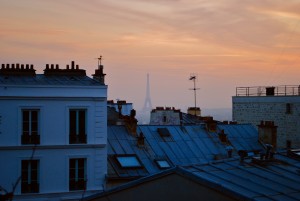
Sunset and the Eiffel Tower over the rooftops of Montmartre
If you’ve seen the French film Amélie, or know a bit about Paris, you may be familiar with the neighborhood of Paris known as Montmartre. It’s probably most well known for the Sacré Cœur Basilica which sits on top of the highest hill in Paris over looking the city. Though this is easily one of the most breathtaking sites in Paris (both the basilica and the view of the city), Montmartre itself is easily one of the most rewarding ways to spend your time in Paris.
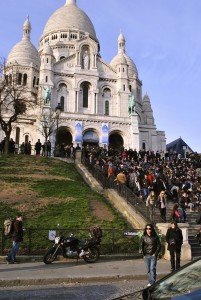
An average day at the Sacré Cœur -tourists, tourists, tourists
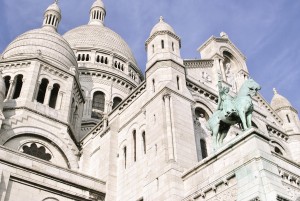
I have yet to see this, but apparently when it rains, the basilica shines even whiter
Admittedly, the draw for me to this part of town was to be one of so many Amélie tourists, I didn’t even care about the fact that the Moulin Rouge is right in front of the metro stop. I mean, of course I made a point of seeing it, but it wasn’t top on my list.
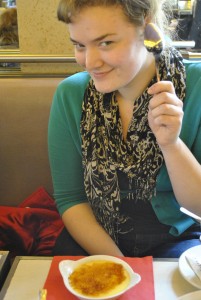
Attempting to be Amélie at the Café des deux moulins
I was sure to eat crème brulée at the café de deux moulins (the restaurant where Amélie works in the movie), and then reenacted with a friend and fellow Amélie fan, perhaps a little too enthusiastically, the scene where Amélie has Nino run up the stairs in front of the Sacré Cœur to retrieve his photo album. Now, these were rewarding enough, but the art and generally-in-love-with-everything-quaint enthusiast in me was just enamored by this neighborhood.
Montmartre used to be a bohemian commune of sorts. The moulin rouge, cafés like the chat noir and the café Lux attracted artists like Toulouse Lautrec, Salvador Dali, and so many other modernist and surrealist influences living in Paris at the time. Housing was cheap, and peers were plentiful. These days, Montmartre is a bit more touristy (ok, a lot more) but artists can still be found lining the streets, painting and selling their works in the market area just next to the basilica.
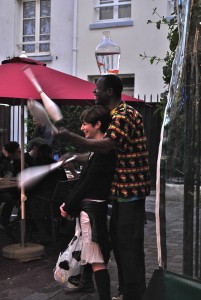
Yes, this man is juggling bowling pins while balancing a fish bowl on his head
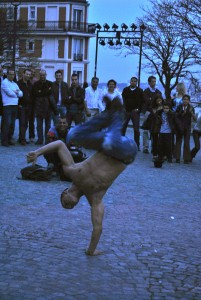
This dance group performs everyday in front of the basilica. They're amazing
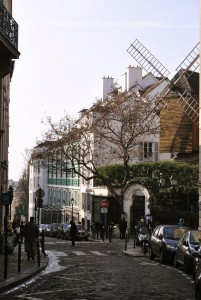
The remaining moulin in Montmartre
The word “moulin” or windmill is a theme throughout the neighborhood thanks to the two windmills that used to be working over the city. These days, only one is still hanging around, and you can’t actually get too close to it, but it’s worth checking out if you’re a fellow fan of quaint things. Montmartre is also home to the only remaining vineyard in the city of Paris. There’s a wine festival here every year, though unfortunately it’s in October, so I won’t get the chance to engage in the festivities.
Despite all the views, and all the sights Montmartre has to offer though, this is also the part of Paris I’ve come to love the most purely for personal reasons. Some of my best memories of the city happened on these extremely steep, narrow streets. I’ve heard Vespers in the basilica, conversed with darling women who routinely come with tuna at 5pm to what we’ve come to call “the Cat Forest” to feed its inhabitants, found a scooter, watched the sunset behind the Eiffel Tower, attempted to watch the sunrise after one very long walk, and shared laughs and a meal of sorts with good friends. The Eiffel Tower might be the symbol of Paris for most, but when I think back on my time in this gorgeous city, my time spent on the hill of Montmartre, in the shade of the Sacré Cœur, will be the first to my mind.
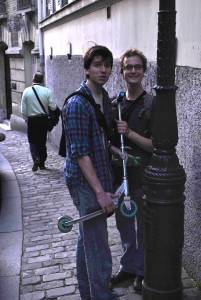
Found a scooter!
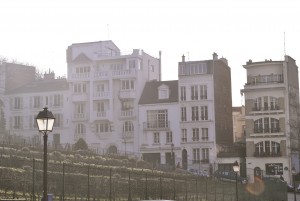
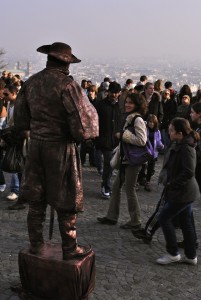
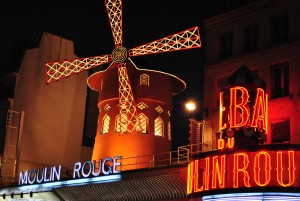
Leave a Reply